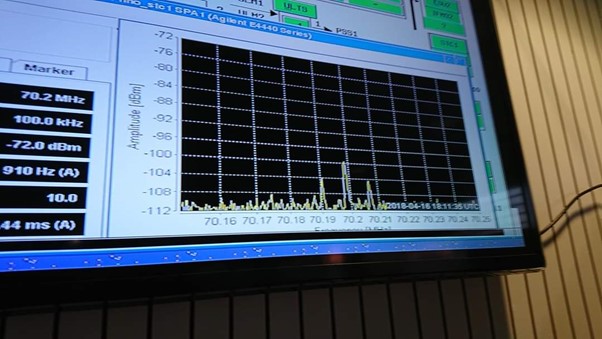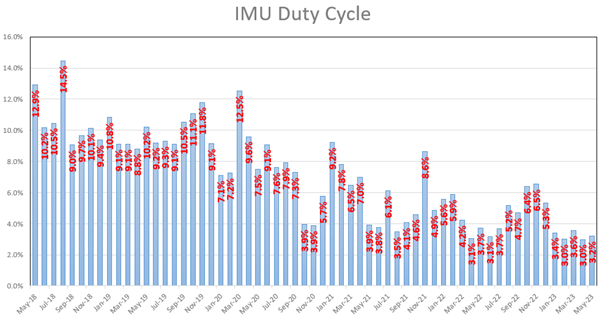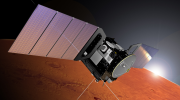Six years ago, in early 2017, the Mars Express team detected that four of its six ring laser gyros were showing signs of aging and that, if nothing was done, the mission would end within the next two years.
The spacecraft needed at least three gyros to be able to control the its attitude, to point the High-Gain Antenna (HGA) at Earth to communicate with the ground, and to point its instruments at points of interest on Mars for scientific observations.
By April of the following year, the mars Express Mission Control Team at ESA’s ESOC operations centre had rewritten the Attitude and Orbit Control System (AOCS) software to include an attitude estimator that didn’t require any input from the gyros. Today, Mars Express has been flying for five years with the gyros switched off most of the time, saving their remaining lifetime for use only when they are strictly necessary.
The AOCS software for the Rosetta spacecraft included a gyroless attitude estimator intended to spare gyro lifetime during its long interplanetary cruise phase. Thanks to the similarity between the software of the two spacecraft, the possibility to adapt the Rosetta gyroless estimator design for Mars Express was put forward as a quick and affordable solution to the Mars Express gyro lifetime problem.
This estimator used a dynamics model to replace information from the gyros using just the Star Tracker input, and allowed the inertial measurement units (IMU) to be switched off. On Rosetta, it was only intended to be used in Earth pointing attitude with low external torques during interplanetary cruise and reverting to Safe Mode if the star tracker lost lock.
Further analysis revealed that the Rosetta estimator could support typical mars Express science pointings. However, for it to be useful for Mars Express, it had to be available in nearly all orbit phases and attitude modes, and in case of loss of star tracker lock, revert smoothly to the gyrostellar estimator with the gyros switched on. To achieve a significant lifetime extension, the gyroless estimator had to be in implemented quickly, while life remained in the gyros and in order to produce large reductions in the duty cycles of the IMUs.
The new software was developed by the Mission Control Team with support from the spacecraft manufacturer AIRBUS, in just one year from initial concept to deployment, which took place in April 2018.
This included modelling the spacecraft dynamics, integration of the gyroless estimator into the AOCS software, and recompilation. It was also necessary to review and revalidate all AOCS Flight Operations Procedures and extensively overhaul the mission planning process, in particular to avoid attitudes where Mars would be in the field of view of the star trackers, which would blind them and prevent them from working correctly.
In early April 2018, the new software was ready and was uplinked to the EEPROM (non-volatile memory) on the spacecraft’s backup flight computer. This process took about two hours to complete, as once loaded, the entire EEPROM then had to be re-dumped back to Earth so it could be checked to ensure the install was complete and correct.
Then, on 16 April, the command was sent to trigger the safe mode that would swap to the backup computer and activate the new software. The team waited with bated breath while the command took 15 minutes to travel the 270 million km to Mars, the safe mode was executed, and then 45 minutes later the signal was received at the ESA ground station in Australia indicating that the new software was running successfully.


After one month of intensive on-board testing, the gyros were switched off for the first time on 16 May 2018.
As of now, the gyroless software has run flawlessly for five years of operation.
The initial aim of the activity was to reduce the duty cycle of the gyros to 10%, in order to extend the mission lifetime until 2025. However, a duty cycle of less than 5% is now being achieved, extending the lifetime of the gyros to the end of this decade.
Although two gyros, number four and six, have now failed, they did so within a few days of their predicted date of failure, giving the Mission Control Team a high degree of confidence in their other predictions.

Today, on 2 June 2023, the Mars Express team will be celebrating another event – the 20th anniversary of the launch of the spacecraft from Baikonur Cosmodrome – a milestone that could not have been reached were it not for this gyroless operations mode.
For more information:
https://www.esa.int/Enabling_Support/Operations/Mars_Express_v2.0
https://issfd.org/ISSFD_2019/ISSFD_2019_AIAC18_Garcia-Juan_Manuel.pdf




Discussion: no comments